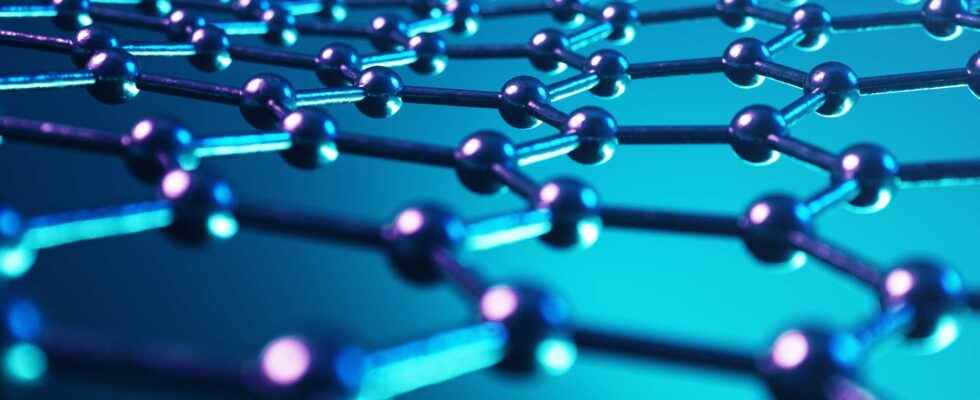Disorder traditionally increases with temperature: the latter is moreover only an indicator of what is called the thermal agitation of the particles. The more we heat, the more we giveenergyand this energy changes, among other things, into movement. But in the case observed by the researchers, and described in a study published in Nature Physics, it’s the opposite. The rise in temperature has brought a form of order among the atoms who make up the material tested. Or more exactly, these are the spins magnetic which are frozen, that is to say oriented in the same direction.
The Frustrated Interactions of Spin Glasses
Whatever the material that we scrutinize in detail, it is composed, on a small scale, of atoms, more or less aligned with each other depending on the type of solid. Each atom or particle that makes up this material has a magnetic spin, an intrinsic property also called “momentum of magnetic spin “. It characterizes the ability of the particle to align with the surrounding magnetic field. The interaction of materials with the electromagnetic field varies according to the atoms that compose it, and their organization. The so-called ferroelectric materials, for example, are part of the insulators, and therefore do not conduct the Electric power. On the other hand, when they are subjected to a electric fieldthem dipole moments electrostatics of the atoms that compose it align with this field. Similarly, a material ferromagnetic can become magnetized under the effect of an external magnetic field, thus aligning its magnetic moments with the field, and then retaining part of this magnetization.
The glasses of spin, materials of which it is question in this study, are not glasses in the traditional direction of the term. They correspond to alloys metals, mixtures of metals, to which are added some magnetic impurities: elements with a magnetic behavior different from that of the others. So, with several magnetisms different within the same material, the magnetic spin moment is oriented randomly. More simply, ” they are often considered messy magnets “says the study. Those are materials called “frustrated”: each atom undergoes contradictory interactions, coming from impurities or elements of the matrix. The spin of the atom cannot stabilize, and is then content to vary randomly.
A counter-intuitive phenomenon
But the material the researchers used is what they call “self-induced spin glass.” It consists only of neodymiuma metal belonging to rare earth. Mixed with iron, it behaves like a magnet. But on its own, everything is different, it behaves like a spin glass: the spins form in it like a “swirling helix”, explains a press release: their direction is constantly changing. In question, “competing interactions derived from the structure of the network itself; […] these competing exchange interactions lead to a multiplicity of low-energy states,” which therefore cause spin orientation frustration. Indeed, in pure neodymium, the researchers found the existence of hexagonal and cubic structures within the material, within which the neodymium atoms interact differently. Thereby, “at low temperature, the two sublattice magnetizations have different tendencies towards magnetic order; that is, they would prefer two different magnetic orders. It is the competition between these ordering tendencies that effectively results in the behavior of spin glass.explain the researchers.
In addition to this amazing property, another strangeness of this material is its behavior in the face of temperature: when it was heated from -268°C to -265°C, instead of wobbling even more, the spins froze! The neodymium then passed from the state of spin glass to that of ferromagnetic ! Then, when the temperature dropped, the random distribution returned. “This ‘freezing’ of the pattern does not normally occur in magnetic materials.explains Alexander Khajetoorians, co-author of the study and professor of scanning probe microscopy at Radboud University. The magnetic behavior of neodymium that we have observed is in fact the opposite of what happens “normally”. It’s quite counter-intuitive, like water turning into an ice cube when heated. » This behavior, very rare in nature, exists for example in Rochelle salt. In this material, there are two Curie temperatures, that is to say temperatures delimiting its permanent polarization. Only between these two temperatures, Rochelle salt becomes ferroelectric. Outside this interval, it is only paraelectric: the dipole moments are present, but do not have a preferred orientation.
Reading ideas for the summer with Futura?
To celebrate the start of the holidays, we offer you the Mag Futura at the preferential price of 15 € instead of 19 €, i.e. a reduction of 20% !
What is Mag Futura?
- Our first paper journal of more than 200 pages to make science accessible to as many people as possible
- 4 major scientific questions for 2022, from the Earth to the Moon
- Home delivery*
*Special offer valid until July 19. Delivery is made in France (excluding metropolitan France), Switzerland, Belgium.
Interested in what you just read?
